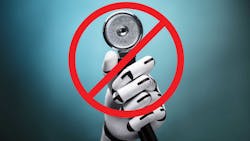More than 25 years ago, I was invited to view the videotape of a robotic gallbladder surgery. It was a fascinating process that demonstrated how with surgeon-controlled probes, a less invasive form of surgery was possible. Just four small incisions in the patient allowed the surgeon to guide the probes, remove the organ and cauterize the point of removal and the surgery was complete.
It was not about a robot replacing a skill, but a robot enhancing a skill. It is this distinction that can get lost in the discussion about robotics as a whole, and in medical applications in particular.
Sean Hägen, founder and director of research and synthesis for BlackHägen, amplifies this point in a recent Machine Design article. “These medical constructs and devices facilitate and increase the abilities of the user, but do not replace them,” Hägen writes. “A surgical robotic system can be considered an extension of the surgeon’s abilities and can impact the rest of the surgical workflow as well as all the other actors involved in the surgical procedure.”
When robotics are discussed, it is seen as the successor to human labor as opposed to the enhancement of it. That is not how it is working out, certainly not in the medical field. Robotics can provide faster, safer and less intrusive procedures, but a doctor still is at the helm in the decision-making process, and the patient is still in charge of care. Those fundamentals shouldn’t ever change.
Those same fundamentals do, of course, apply to the rest of robotics use across manufacturing sectors, but there still are pockets of confusion over the proper role of robots in our plants, and in our lives. The technology shouldn’t replace the human endeavor; it should enhance it. The best robotics deployments have done just that.
Manufacturing long has been seen by those who don’t know anything about manufacturing as dark, dirty and dangerous. The robotics revolution has helped fully debunk this myth, just as it should reaffirm the value of the human worker in our operations.
Manufacturing is not as dramatic as surgery. But the vital role of technology in making manufacturing safer, smarter and more efficient has created the potential for a dramatic change in our lives and in our work.
About the Author

Bob Vavra
Editor Emeritus, Machine Design and Power & Motion
Bob Vavra is the former senior content director of Machine Design and Power & Motion.
